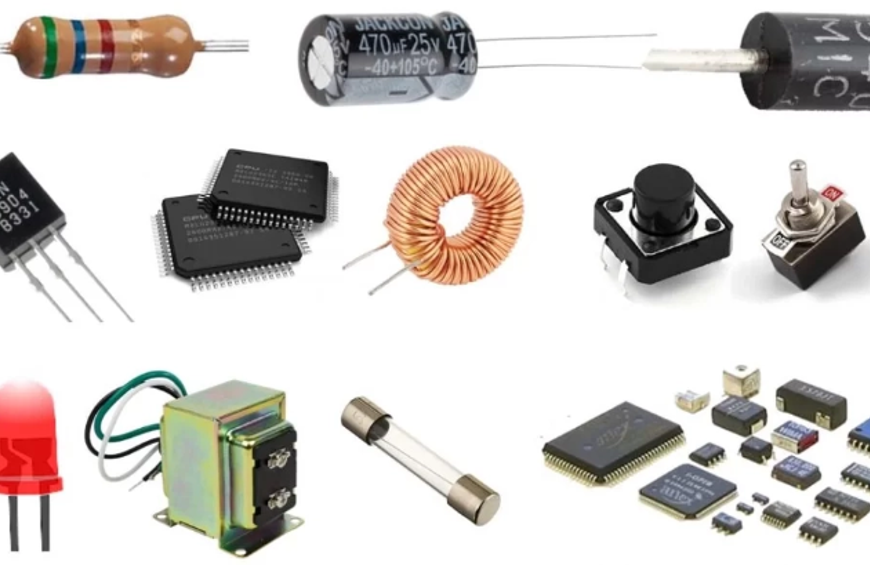Electrical components form the backbone of any electrical system, enabling the transfer, modification, and control of electric power and signals. Understanding these components is essential for electricians, engineers, and enthusiasts working with electrical systems. This article provides a detailed look at key electrical components, their functions, types, and applications.
1. Resistors
Resistors are fundamental electrical components that restrict the flow of electric current in a circuit, dissipating energy as heat.
1.1 Types of Resistors
- Fixed Resistors: These resistors have a fixed resistance value, commonly used in circuits where a constant resistance is required.
- Variable Resistors: Also known as potentiometers, these allow resistance adjustment, used in applications like volume control.
- Thermistors: Temperature-dependent resistors, useful in temperature-sensing applications.
1.2 Applications of Resistors
Resistors are found in devices like televisions, radios, and computers to limit current, reduce signal strength, and divide voltage.
2. Capacitors
Capacitors store and release electrical energy in a circuit, with the ability to discharge energy when needed.
2.1 Types of Capacitors
- Electrolytic Capacitors: Known for high capacitance values, often used in power supply circuits.
- Ceramic Capacitors: Known for stability and non-polarized nature, suitable for high-frequency applications.
- Tantalum Capacitors: Compact with high capacitance, ideal for portable electronic devices.
2.2 Applications of Capacitors
Capacitors are widely used in timing circuits, filters, and power supply systems. They stabilize voltage and smooth out electrical fluctuations.
3. Inductors
Inductors are components that store energy in a magnetic field when electric current flows through them.
3.1 Types of Inductors
- Air-Core Inductors: Suitable for high-frequency applications, as they have low inductance.
- Iron-Core Inductors: Used in applications requiring higher inductance values, like audio equipment.
- Ferrite-Core Inductors: Known for high permeability, commonly used in power supplies and radio frequency circuits.
3.2 Applications of Inductors
Inductors are essential in tuning circuits, transformers, filters, and energy storage in power supplies.
4. Diodes
Diodes allow current to flow in only one direction, providing essential functions like rectification, switching, and signal modulation.
4.1 Types of Diodes
- Rectifier Diodes: Convert AC to DC, used in power supply circuits.
- Zener Diodes: Allow reverse current flow at a specified voltage, crucial for voltage regulation.
- Light Emitting Diodes (LEDs): Emit light when current flows through the,m used in displays and indicators.
4.2 Applications of Diodes
Diodes are used in voltage regulation, signal demodulation, and lighting applications. They protect circuits by blocking reverse current flow.
5. Transistors
Transistors are semiconductors used as amplifiers, switches, and oscillators in electrical circuits.
5.1 Types of Transistors
- Bipolar Junction Transistors (BJTs): Consist of NPN and PNP types, used for amplification.
- Field Effect Transistors (FETs): Known for high input impedance, suitable for low-power applications.
- MOSFETs: Widely used in digital and analog circuits for their efficiency in high-speed applications.
5.2 Applications of Transistors
Transistors are key in amplification, signal modulation, and power management in devices like computers, radios, and televisions.
6. Transformers
Transformers transfer electrical energy between circuits through electromagnetic induction.
6.1 Types of Transformers
- Step-Up Transformers: Increase voltage for efficient power transmission over long distances.
- Step-Down Transformers: Reduce voltage, making it suitable for household and industrial equipment.
- Isolation Transformers: Provide electrical isolation between circuits, enhancing safety.
6.2 Applications of Transformers
Transformers are vital in power distribution, audio systems, and electronics that require voltage changes.
7. Switches
Switches are used to control the flow of electricity by opening or closing a circuit.
7.1 Types of Switches
- Toggle Switches: Manually operated switches, commonly used in household appliances.
- Push Button Switches: Momentary switches activated by pressing, used in devices like doorbells.
- Rotary Switches: Rotate to different positions to connect circuits, suitable for multi-function devices.
7.2 Applications of Switches
Switches are essential in any device that requires manual or automatic control of electrical flow, from home appliances to industrial machinery.
8. Relays
Relays are electromagnetic switches that control circuits remotely, often used in automated systems.
8.1 Types of Relays
- Electromagnetic Relays: Use a magnetic field to open or close contacts, commonly used in automotive applications.
- Solid State Relays: Use semiconductor components, suitable for high-speed and low-noise switching.
- Thermal Relays: React to temperature changes, protecting circuits from overheating.
8.2 Applications of Relays
Relays are used in telecommunication, automotive, and industrial automation systems to manage multiple circuits.
9. Fuses and Circuit Breakers
Fuses and circuit breakers protect circuits from overcurrent, which can cause overheating and damage.
9.1 Types of Fuses
- Glass Fuses: Used in electronics and household appliances for short-circuit protection.
- Ceramic Fuses: Withstand higher temperatures, suitable for industrial applications.
- Thermal Fuses: Designed to blow at a specific temperature, offering protection from overheating.
9.2 Types of Circuit Breakers
- Miniature Circuit Breakers (MCBs): Protect low-voltage circuits from overloads and short circuits.
- Residual Current Circuit Breakers (RCCBs): Detect leakage currents, protecting against electric shocks.
- Molded Case Circuit Breakers (MCCBs): Handle higher current ratings, suitable for industrial settings.
9.3 Applications of Fuses and Circuit Breakers
These components ensure safety in electrical systems, used in homes, factories, and power distribution networks.
Conclusion
Electrical components are integral to all electrical and electronic systems, each with specific functions and applications. Understanding these components and their correct applications is essential for anyone working in the field of electronics or electrical engineering. From resistors to circuit breakers, each component plays a crucial role in ensuring efficiency, safety, and functionality in electrical systems.











